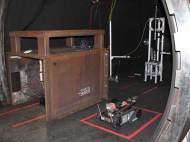LEXI robot aids in explosive testing
 Researchers at the Lawrence Livermore National Laboratory (LLNL) have devised a new robot used for explosive tests in the National Explosives Engineering Sciences Security (NEXESS) Center. The platform they chose as a base for their robot is iRobot Packbot 510 – a robot manufactured by the same company that created the Roomba vacuum-cleaning robot – and named their robot Livermore Explosives iRobot or LEXI.
Researchers at the Lawrence Livermore National Laboratory (LLNL) have devised a new robot used for explosive tests in the National Explosives Engineering Sciences Security (NEXESS) Center. The platform they chose as a base for their robot is iRobot Packbot 510 – a robot manufactured by the same company that created the Roomba vacuum-cleaning robot – and named their robot Livermore Explosives iRobot or LEXI.
“We need to see what a terrorist might use and how effective certain types of explosives might be in bringing down planes and other targets of interest. There are a lot of materials that we look at, and many are safe to work with in contact, such as with your hands, if you know what you are doing”, said Lee Glascoe, who heads LLNL’s participation in NEXESS. “But there are many that are not; particularly if they have certain additives like sulfur or aluminum. Typically the explosives’ ingredients handled by themselves are benign, but mixed together, they become dangerous.”
Chemist Sabrina DePiero follows a procedure she developed to increase the safety during the explosives testing process. She carefully layers two or three ingredients including a fuel and oxidizer in a plastic container. The materials are taken to one of several firing tanks of LLNL’s High Explosives Applications Facility (HEAF) which contain acoustic mixers. When the container with the explosive mix is in place, she exits and the tank and secondary doors are closed.
The acoustic mixer vibrates the materials at the system’s resonance frequency to create the fully mixed explosive. In order to prevent damage to the robot if the mixture explodes during remote mixing operation, LEXI is parked behind a blast shield inside the tank. After the procedure is complete, LEXI rolls to the mixer and removes the cylinder containing the explosive mix and transports it to the tank’s firing table. Once that delicate task is complete, the tank door is opened, LEXI rolls out, and the explosives can be detonated.
“A real challenge was configuring LEXI and all the equipment for making, mixing and handling these explosives at HEAF. Before LEXI, we weren’t able to look at some of these explosives because of safety concerns”, said Glascoe.









Leave your response!